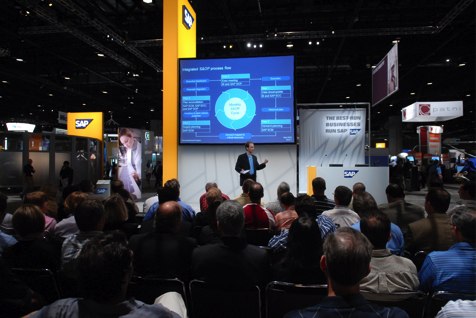 So, once again, SAP invited me to its annual SAPPHIRE and ASUG event. I find myself wondering if SAP will get return on their investment in me once again. The answer is, probably not. I’d like to think this is not my fault. For instance, if you search the hundreds of events SAP has listed on its agenda for customers, press, and partners for the words “Enterprise 2.0,” two sessions return. One is run by @matzeller (Matthias Zeller of Adobe) and the other is @finnern (SAP’s Mark Finnern, community evangelist), both on the last day and at the same bad time slot. (Great). Both Zeller and Finnern were with me in the blogger’s corner. If you broaden the search to “Web 2.0,” three sessions return. (Sigh).
So, once again, SAP invited me to its annual SAPPHIRE and ASUG event. I find myself wondering if SAP will get return on their investment in me once again. The answer is, probably not. I’d like to think this is not my fault. For instance, if you search the hundreds of events SAP has listed on its agenda for customers, press, and partners for the words “Enterprise 2.0,” two sessions return. One is run by @matzeller (Matthias Zeller of Adobe) and the other is @finnern (SAP’s Mark Finnern, community evangelist), both on the last day and at the same bad time slot. (Great). Both Zeller and Finnern were with me in the blogger’s corner. If you broaden the search to “Web 2.0,” three sessions return. (Sigh).
The reality is SAP and its global customer base are just not ready for the socialization of the enterprise. It’s just not a topic that commands attention at this massive event (despite my valiant efforts to bring it up in every executive briefing). The majority of conversations at SAPPHIRE revolve around common themes such as decision-making, analysis, data, spreadsheets, databases, reports, statistics, and business processes. In other words, the real work that goes on in real businesses. Is that surprising? No. SAPPHIRE is to SAP what Disney World is to young families. (The Orlando location only reinforces my impression). With the pressure on to decrease costs and make smarter, faster decisions based on easily accessible real-time data, SAP customers and its ecosystem of suppliers and partners were buzzing with excitement and possibilities here. Extending the metaphor, Enterprise 2.0 might be considered the Pleasure Island nightclub of the enterprise (which Disney closed last summer, btw). Just an aside– whenever I was face to face with a “real” customer and it happened several times as I did some reporting-by-walking-around, I would ask the simple question: “Have you ever heard of Enterprise 2.0?” The answer was unanimous: “No.”
So, what can we deduct from this experience? SAPPHIRE may just be the best harbinger of the Enterprise 2.0 market’s maturity. Last year, if I searched on Enterprise 2.0, I’m fairly certain I would have found zero returns for scheduled sessions. That there are two this year is, indeed, progress. Further, the soft language of 2.0 has seeped into SAP’s strategic speak and hopefully, strategic consciousness. Leo Apotheker, SAP’s co-CEO and reigning commander in chief name-dropped a smattering of prevailing social buzzwords in his opening address i.e., transparency, collaboration, trust, and social communities. So, a big high-five from me to the speech writer for positioning SAP as a “we get it.” And, in reality, they do get it. They just haven’t incorporated deep social-collaborative functionality into their product suites (yet). This is about where the majority of large customers are. They “get it.” Some may be even experimenting with it (even if they’re not calling it Enterprise 2.0), but it’s not yet core to their business.
We spent some time with Marge Breya, EVP and GM for Business Objects who assured us in the next 6 – 12 months we’d see major social software additions to SAP’s traditional software, but was reluctant to say anything further. I encountered that reaction many times from even my fellow bloggers/analysts who were sworn to secrecy on SAP’s 2.0 plans. Some of the innovation may come from SAP’s innovation labs where the petri dish is hopping already with social trials. For me, the best demonstration at SAPPHIRE was by Timo Elliott, Senior Director of Strategic Markets, BusinessObjects Innovation Center. Elliott showed us  various efforts that they’re testing in the labs including a social network analysis tool, but he too was very careful to make it clear that none of the existing experimental work was officially sanctioned as a product offering or improvement. Elliott also pointed us to a rogue, yet informative, web 2.0 site he manages where he is tracking how SAP uses 2.0 with its customers and partners, as well as explains various 2.0 projects underway within SAP.
various efforts that they’re testing in the labs including a social network analysis tool, but he too was very careful to make it clear that none of the existing experimental work was officially sanctioned as a product offering or improvement. Elliott also pointed us to a rogue, yet informative, web 2.0 site he manages where he is tracking how SAP uses 2.0 with its customers and partners, as well as explains various 2.0 projects underway within SAP.
Once again, I’m reminding that we’re still super early in our evangelism. I sensed some of the SAP employees I spoke to also felt some of that frustration and dare I say, disappointment, that the needle is moving so slowly in the enterprise. Next month, of course, I will be attending the Enterprise 2.0 conference in Boston. I’m sure I’ll be re-energized there, although I remember good ole’ Tom Davenport who debated Andrew McAfee at the first conference in 2007 where he pooh-poohed Enterprise 2.0 in general. Davenport was right then, and he continues to be. I understand more now what he meant when he said, “I feel like an atheist at a Baptist convention” on the day of the debate. At SAPPHIRE, I was feeling a little like a Baptist at an atheist convention. SAP may one day stand for Social Applications and Programs, but it’s not clear to me when that day will arrive. (Or– why it should, frankly. Which is a blog post for another day.)







 So, once again, SAP invited me to its annual
So, once again, SAP invited me to its annual  various efforts that they’re testing in the labs including a
various efforts that they’re testing in the labs including a